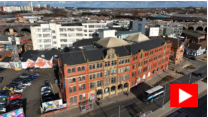
© Birmingham Picture Library, 2025



Birmingham
Resources for a School Trip
Birmingham, in the heart of the UK, is its second- largest city with a population of 1.2 million. It has a rich history of industry and innovation, shaping both Britain and the wider world. Growth and Industry Birmingham became a market town in 1368, developing industries in leather, pottery, and later metalwork. By the 18th century, it was a global centre for small metal goods like buttons and buckles, known as ‘Birmingham toys.’ It also played a controversial role in the arms trade, supplying guns used in conflicts and the transatlantic slave trade.Industrial Revolution & Victorian
Innovation
Matthew Boulton built the world’s first factory, producing fine metal goods. His partnership with James Watt led to steam engines that powered industry worldwide. The ‘Golden Boys’ statue in Centenary Square commemorates them and engineer William Murdoch. The city also pioneered electroplating and mass-produced pen nibs.20th Century & Regeneration
Birmingham manufactured warplanes like the Spitfire and, by the 1960s, produced over half of Britain’s cars. As industry declined, the city shifted to finance and services, attracting firms like HSBC and PwC. The 1980s saw major regeneration, linking city squares with pedestrian routes and adding public art. Digbeth, once an industrial hub, is now a creative quarter with street murals.Looking Ahead
Today, Birmingham has a diverse economy, with finance and services making up 35%. Five universities support education and research. HS2 will soon cut travel to London to 40 minutes, and new skyscrapers are reshaping the skyline.Resources
• Photography for download for display/projects: FREE photos for schools here….. • Discovering Birmingham book here….. • Birmingham’s Public Art book here….


























